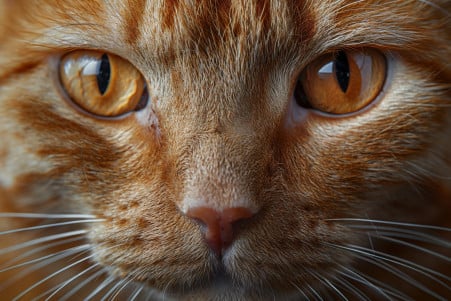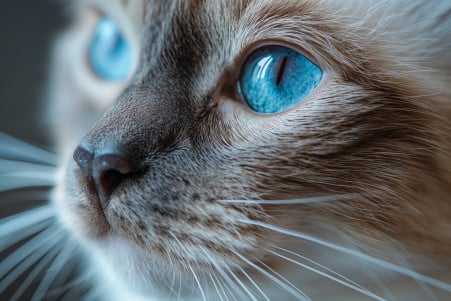Why Do Cats Have Eyelashes? The Purpose of Feline Eyelashes
4 March 2024 • Updated 4 March 2024

Cats’ eyes are often the most striking thing about them, but the purpose of their eyelashes is a little less obvious. Cats do have eyelashes, or cilia, which are the tiny hairs that line their upper eyelids. Although they’re not as noticeable as human eyelashes, feline eyelashes protect cats’ eyes from foreign objects and help them make the most of their sensitive sensory whiskers.
This article will delve into the world of veterinary anatomy and ophthalmology to explain the form and function of cat eyelashes. This will also include a look at the unique qualities of cat whiskers and the third eyelid, providing a complete picture of the protective systems that help cats maintain their vision. This study will show how these systems help cats stay healthy, offering an in-depth understanding of the complexities of feline eye care.
Why do cats have eyelashes?
What Do Cat Eyelashes Do? The Science of Feline Eyelashes
Cats do have eyelashes, although they are much less noticeable than human eyelashes. These small hair-like structures help protect the eyes from dust and other debris. According to Hepper, cats have eyelashes on both their upper and lower eyelids, and they help keep the eyes safe in conjunction with the protective powers of a cat’s whiskers.
The length of a cat’s eyelashes can differ from breed to breed, with long-haired cats like Ragdolls and Maine Coons having more noticeable eyelashes and hairless cats like the Sphynx having none, says My British Shorthair.
The main function of cat eyelashes is protective, helping to keep irritants out of the eyes. However, eyelashes can also be impacted by disorders like distichiasis, ectopic cilia, or trichiasis, according to Catster.
These disorders can lead to issues like red eyes, squinting, and swelling, and they will require a trip to the vet. Knowing about the anatomy and potential issues of cat eyelashes can help you know when your cat needs to see the vet.
Understanding the Complexities of Cat Eyelash Disorders
Cats can suffer from a variety of eyelash disorders, some of which are more painful than others. The most common eyelash disorders in cats are distichiasis, ectopic cilia, and trichiasis, all of which are characterized by abnormal eyelash growth that can cause eye damage and discomfort. Symptoms of these disorders include excessive blinking, changes in eye color, swelling, discharge, and the cat rubbing or scratching at their eyes.
Diagnosing these disorders starts with recognizing the symptoms and seeking help from a veterinarian. The diagnostic process, according to Wag, can include a complete physical exam and a number of specialized tests, such as the Schirmer tear test to measure tear production, an intraocular eye pressure test, and a fluorescein eye stain test to detect corneal ulcers.
Veterinarians can treat these disorders in a number of ways, with mild cases often being treated with eye drops. However, severe or chronic cases of eyelash disorders may require surgery to remove the affected eyelashes or hair follicles, according to Wag. Aftercare is important to ensure that the cat heals properly and that the disorder doesn’t return, which can include additional appointments and at-home eye care.
Knowing the balance between a cat’s eye health and the disorders that can affect it is important for keeping your cat healthy. With the right information and care from a veterinarian, most eyelash disorders can be treated effectively, allowing our feline friends to continue to see the world around them.
The Nictitating Membrane: What It Is and What It Does
One of the most interesting features of a cat’s eyes is the nictitating membrane, or third eyelid. The third eyelid is a fold of tissue that helps protect the eye, and it has two important functions. First, it acts as a windshield wiper, sweeping across the eye to clear away any dirt or debris that may have accumulated. Second, it helps spread tears across the eye to keep it moist and healthy.
The third eyelid is more than just a thin layer of tissue. It also contains T-shaped cartilage and an accessory lacrimal gland, both of which help it do its job. The cartilage makes the membrane stiffer and more protective, while the gland helps produce tears. The third eyelid is also controlled by smooth muscle and the sympathetic nervous system, which helps it move in response to threats to the eye.
In addition to its protective functions, the third eyelid can also be an important diagnostic tool. When a cat’s third eyelid is visible, it’s often a sign that something is wrong. In fact, a visible third eyelid is often the first sign that a cat is sick.
It can be caused by a variety of issues, from minor eye infections to more serious systemic diseases. While the third eyelid is normally hidden from view, if it’s visible for more than a day or two, it’s important to take your cat to the vet.
Knowing what the third eyelid does and how it works makes it clear that it’s an important part of a cat’s eye. Not only does it help protect the eye, but it can also be an important indicator of a cat’s overall health. Like the other parts of a cat’s eye, the third eyelid is an example of the way evolution has honed cats’ senses to make them the animals they are today.
Whiskers: A Back-Up Sense
Whiskers, also known as vibrissae, are a cat’s built-in radar system, and they are essential to a cat’s spatial awareness and safety. PetMD notes that these tactile hairs are jam-packed with nerve cells that help cats feel their way through their environment, protecting their eyes and face from potential dangers.
In addition to helping cats assess how much space they have in any given situation, whiskers also help cats move around in the dark, making up for their lack of visible eyelashes and acting as a second line of defense for their eyes.
Whiskers are so sensitive that they even help cats communicate, according to Four Paws. When a cat’s whiskers pick up on changes in the air or brush up against something, they let the cat know if they are in danger or if they have a clear path, indirectly protecting their vision.
The Blue Cross warns against trimming a cat’s whiskers, as it can lead to disorientation and stress, much like it would if a human were to lose their sense of touch.
Keeping a cat’s whiskers intact is important for their physical and mental health. Knowing and understanding the roles of both whiskers and eyelashes, and how they work together to protect cats, is important for helping our feline friends feel safe and secure in the world.
Evolutionary Insights: The Purpose of Eyelashes in Different Species
Eyelashes aren’t just a human beauty feature, they also have a purpose in other species.
A study in the Journal of the Royal Society Interface by the Georgia Institute of Technology determined that the ideal length of eyelashes is one-third the width of the eye of the species in question.
This specific ratio helps to minimize air flow around the eye, which in turn minimizes the risk of dryness and the chance of airborne particles getting in the eye. Cats, who have shorter eyelashes, may use other protective measures like their third eyelid more, as was suggested by a study on the aerodynamics of eyelashes.
This knowledge has a wider impact. The Los Angeles Times noted that a Georgia Tech study found that eyelash-inspired designs could improve dust protection for sensors and solar panels. As a result, the purpose and length of eyelashes don’t just protect eyes in the animal kingdom, they also help to advance technology, showing how important they are to both biological evolution and engineering advancements.
Take a Moment to Paws: The Last Word on Cat Eyelashes
After a deep dive into the world of cat anatomy, we can confirm that cats do have eyelashes, or cilia, and that these lashes are the first line of defense against foreign objects. While they may be less noticeable than human eyelashes, they are just as important in keeping the eyes healthy by filtering out dust and other debris.
The protective system that cats have in place to keep their eyes safe goes beyond the cilia, with whiskers and the third eyelid, or nictitating membrane, also playing a role in keeping the eyes safe. Whiskers help cats with their spatial awareness, which can help them avoid potential eye hazards, while the third eyelid provides an extra layer of protection and helps keep the eye moist.
It’s important for cat parents to know the signs of eyelash disorders and to understand the importance of catching these issues early and getting their cat to the vet. By paying attention to these signs, cat parents can help ensure that their cat’s eyes stay healthy and that their cat remains comfortable.
In the end, knowing the evolutionary function and the complex way these protective systems work together can help us better understand cat health and give us a greater appreciation for the complexities of nature. As the protectors of our feline friends, it’s our job to make sure that these systems stay intact so that our cats can live long, healthy, and happy lives.


